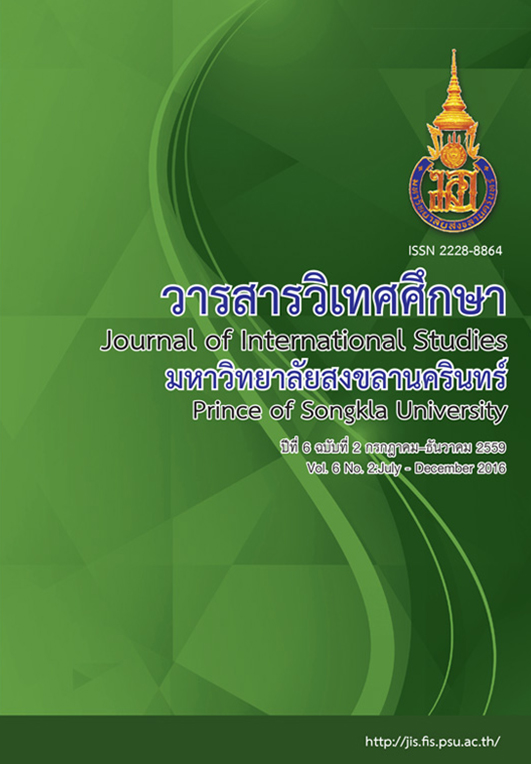A comparative study of directional complements in Chinese and Thai languages: “进 (jìn)”group and“เข้า (khaˆw)”group
Main Article Content
Abstract
The purpose of this article is to compare the directional complements in Chinese: “进 (jìn)”group and the directional complements in Thai: “เข้า (khaˆw)”group by using the theory of cognitive linguistics. Through the comparison we found according to their grammatical meanings; they have the same directional meaning and different result meaning. Besides, “进 (jìn)”group has figurative expressions, but “เข้า (khaˆw)” group has not. Where as “เข้า (khaˆw)” group has the state meanings and can be used in a few idioms, but “进 (jìn)”group cannot. According to our database, some adjectives and verbs can be only collocated with “เข้า (khaˆw)”group, but cannot be collocated with “进 (jìn)”group. In addition, regarding the corresponding forms, “เข้า (khaˆw:进)” group has more than “进 (jìn)” group. The corresponding relationships are related to the grammatical meanings, the central sense, the standpoint, the view of attention, and the prominence view wihich can create different or even the same conditions.
Article Details
Statements and opinions expressed in articles herein are those of the authors and do not necessarily reflect the position of the editors or publisher.
Article, information, text, image, etc. which are published in Journal of International Studies, belong to Journal of International Studies. If anybody or any organization would like to use part or whole of them, they must receive written permission from Journal of International Studies before usage.
References
Lakoff, G. & Johnson, M. (2003). Metaphors we live by. Chicago: The University of Chicago. (Original work published 1980)
查·勾吉迪。(1985)。翻译者栾文华。判决。北京:长江文艺出版社。
蓝 纯。(2005)。认知语言学与隐喻研究。北京:外语 教学与研究出版社。
老 舍。(2009)。骆驼祥子(2版)。北京:人民文学出版 社。
刘月华。(2008)。趋向补语通释(2版)。北京:北京语言大学出版社。
吕叔湘。(2004)。现代汉语八百词,增订本(13版)。北京:商务印书馆。
吴素兰。(2012)。汉泰动词后“上”组与“ขึ้น”组、“下” 组与“ลง”组对比研究,北京语言大学研究生院博士论文,北京。
杨德峰。(2009)。趋向补语的认知和习得研究,北京语言大学研究生院博士论文,北京。
张 斌。 (2001)。现代汉语虚词词典。北京:商务印书馆。
张 敏。 (1998)。认知语言学与汉语名词短语。北京:中国社会科学出版社。
赵秀芬。(2000)。汉泰趋向补语对比研究,北京语言大学人文学院硕士论文,北京。
ชัชวดี ศรลัมพ์. (2538). การศึกษามโนทัศน์ของคำว่า เข้า. วิทยาพนธ์อักษรศาสตรดุษฏีบัณฑิต คณะอักษรศาสตร์, จุฬาลงกรณ์มหาวิทยาลัย.
ชาติ กอบจิตติ. (2524). คำพิพากษา, กรุงเทพฯ: ต้นหมาก.
เธียรชัย เอี่ยมวรเมธ. (2550). พจนานุกรมจีนไทย ฉบับใหม่ (ฉบับพิมพ์ตัวย่อ), กรุงเทพฯ: รวมสาส์น (1977).
เธียรชัย เอี่ยมวรเมธ. (2549). พจนานุกรม ไทย-จีน-อังกฤษ ฉบับ 60,000 คำ, กรุงเทพฯ: รวมสาส์น (1977).
老舍.(2533). เนียน ผู้แปล. ชีวิตเลือกไม่ได้ของสามัญชนคนลากรถ, กรุงเทพฯ: รวมทรรศน์.
นววรรณ พันธุเมธา. (2527). ไวยากรณ์ไทย, กรุงเทพฯ: รุ่งเรืองสาส์น.
พัน เต๋อ ติ่ง.(2527). การใช้คำเสริมกริยาบางคำ, วารสารอักษรศาสตร์, (16), 73-96.
วิจินตน์ ภาณุพงศ์. (2543). โครงสร้างภาษาไทย: ระบบไวยากรณ์, กรุงเทพฯ: มหาวิทยาลัยรามคำแหง.
หทัย แซ่เจี่ย. (2542). การเปรียบเทียบคำเสริมกริยาบอกทิศทาง“SHANG” “XIA” ในภาษาจีนกลางกับคำภาษาไทยในลักษณะเดียวกัน, วิทยาพนธ์อักษรศาสตรมหาบัณฑิต, คณะอักษรศาสตร์ จุฬาลงกรณ์มหาวิทยาลัย.


